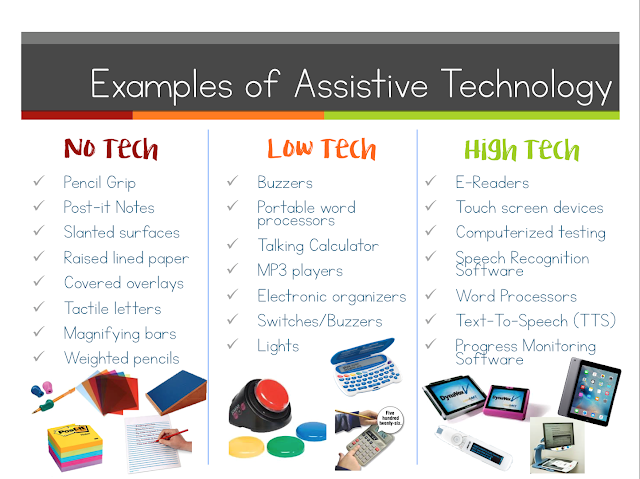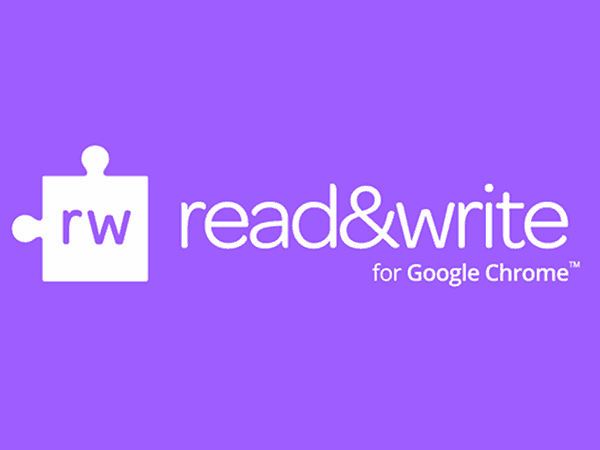This week we had another excellent presentation from Megan, Leigh, Jenny, and Kalyn on assistive technologies. Like some people in our class, my knowledge on these technologies is pretty limited. I use the basics in my classroom, but I haven’t had a whole lot of experience teaching students who use some of these more intense technologies on a daily basis. In most of my experience, the students I have taught have used apps like Google Read and Write, Google Translate and other translating apps, smart devices or chromebooks, audiobooks, and planners or low tech organization tools. Some students need scribes or to type their exams, or need extra time for assignments or exams, etc. When it comes to expertise in the area of assistive technology, I’m pretty low tech and inexperienced!
When students are in need of assisitve tech tools in my classroom, I don’t agree with the stigma that can be attached to using them, such as using Google Read and Write or audiobooks in classrooms. Often I offer these tools to all my students, giving them all the opportunity to use them, explaining that we all learn differently so why not use the tools you need to be more productive and make learning or writing easier? The article, Assistive Technology: Impact on Education, employment, and independence of individuals with physical disabilities (Stumbo, N., Martin, J., and Hedrick, B, 2008) even stated that, “about 76% of children who received AT were able to remain in a regular classroom, and about 45% were able to reduce school-related service” (100). This is significant when we are talking about students with physical disabilities as the article states, but also for students with behavioural issues and other learning disabilities within our classrooms.
I absolutely love using graphic organizers in my ELA classrooms! They are so helpful for students to organize thinking, brainstorming, and allowing me to see students’ thinking processes as well. I often make students hand in their outlines and organizers before we begin essay writing and some students feel it’s an unnecessary step, but others need it. The ones who think it is unnecessary also learn valuable skills – like how to break down their thinking and explain how they got to a certain point instead of just doing it (a.k.a. metacognition). The students who need those extra steps also benefit from the slow down process and don’t feel that stigma of “needing” the help to get started. I am even going to attempt to use graphic organizers for notes in my Calculus course block three and encourage students to make their own helpful notes for the future. I have to thank Peter Liljedahl and his Building Thinking Classrooms mentality. If you teach math, I strongly recommend his book and following him on twitter!
Another adaptation I use most frequently in my classroom is playing audiobooks when we are doing novel studies or studying Shakespeare because it gives so much more context to the play. I was surprised how many of my students loved this option for reading books and used it frequently. There are a lot of novels we read in Grade 12 that are contextually difficult and the audiobooks make it much easier to comprehend. I also tell my students I enjoy using Google Read and Write to help me write sometimes, do research jot notes, or simply complete a task faster than physically typing.
I like to allow my students to use laptops and apps on their devices to complete their assignments all the time. Once again, this draws the attention away from students who absolutely need the tools and from students asking, “why do they get to use a laptop and I can’t?” I love having an inclusive classroom and allowing students to show their learning how they can best and make it easier for all students to stay focused and completing their tasks. This is significant when we are talking about students with behavioural issues, mental and physical barriers within our classrooms.
As I don’t have a whole lot of experience using the techier tools in my classroom, the experiences I do have using them stand out a little more. Using Read and Write has become the most common tool I end up using with students to help them with the writing process. I’m sure I have barely scratched the surface of this tool, but its capabilities are quick impressive. Giving my students the opportunity to speak out their words is an awesome way for them to make progress quickly on exams, essays, and other assignments, but one of the drawbacks is they need a quiet place to work where they also will not be overheard. This can be a challenge in our building and in my classroom. I obviously can’t have a few students speaking out their essays at the same time as others trying to work quietly; it just doesn’t work. Not to mention, it is distracting for others around and the students speaking out loud could be self conscious of their words. The highlighting functions and screen reading tools are also awesome to use for research and also showcasing how to complete research online with students. Another great feature is that it is free and easily accessible on chromebooks and Google Chrome!
I would think one of the biggest drawbacks is price for many of the higher tech tools. Such tools are great for students who really need them but achieving funding can be incredibly difficult. Another drawback of assistive technology according to this blog post, Assistive Technology: What It Is and How It Works includes the point that AT cannot “make learning and attention issues go away.” I could see some people expecting that using the more high tech assistive technologies with students would solve all their problems but the truth is that these tools need to be used effectively and appropriately or there really isn’t a point in using them at all. If there is limited education behind why we use a certain assistive technology with students, it could become more distracting than helpful to the student in need.
It’s also important to recognize that these tools don’t “make up for ineffective teaching” and can’t be used as replacements for good teaching. Adaptations and differentiated instruction are still essential to using these tools to their full potential and allowing the students who need them to benefit the most from their uses. Education, professional development, and time are essential for teachers when it comes to apps like Google Read and Write, Evernote, Notability or PECS. If teachers are given education on these tools, they will be able to use them effectively with students in their classrooms.
Stumbo, N., Martin, J., and Hedrick, B (2008) state, “AT is meant to improve functional independence by circumventing environmental barriers, maximizing personal independence, and increasing activity participation. This, in turn, then affords greater opportunity for societal participation and integration, including in institutions of higher education and the workforce” (101). Used properly, students have more opportunities than they ever had without these tools and it doesn’t have to be super fancy and techy to be successful and meaningful. Sometimes all it takes is the right plan and the right idea to help make student’s life easier, more impactful and engaging toward the future.
I know I will be spending more time educating myself on the cheaper options available to my students so I can be a more effective teacher and help my students find the right tools to help them in school and beyond.
Until next time,
Shelby








Hi Shelby,
I loved reading your post! Just like you, I have very limited knowledge of assistive technology. I agree with you on the importance of graphic organizers. I ALWAYS use them with my EAL students. It helps them organize their ideas and give their writing a nice flow. I also use the Expanding Expression Tool (EET) with my younger students to help them with gathering ideas. I would like to experiment with coding, since I think Scratch or Minecraft could make writing more fun and accessible for all of our students.
Thank you for sharing your thoughts,
Melinda
LikeLiked by 1 person
Great post Shelby! Many of the ‘low’ tech devices I also didn’t think about until this week’s presentation. I always use graphic organizers when doing writing in ELA. My students are in grade 6 and many of them are working significantly below this level. I have also used Google Read and Write with a few students. I also had a hard time finding a place that is quiet enough that this app works. I like your idea of having all students use these technologies to reduce the stigma for those that need them. I am going to start doing this. Thanks for the suggestion.
LikeLiked by 1 person
Thanks for a great read Shelby! I too have found that my students enjoy audio books, and if given the choice on Raz Kids most of my students will choose to listen to the stories instead of reading them. My students often use the google read and write app as well. In addition, I agree with your statement that “if there is limited education behind why we use a certain assistive technology with students, it could become more distracting than helpful to the student in need”. I find this is an area that many teachers would benefit from having professional development in, especially if it is for a high tech technological device that they have never used with a student before.
LikeLiked by 1 person
I love your post! I am the same and let all students have the option of using Google Read and Write (or any other tool that helps them). I too, tell the students that we all learn differently and we all have strenghts and weaknesses. I actually have had students do a Show What You Know about Google Read and Write in class. They loved it. They were the experts who had mastered it so after the demonstration the other students had the option of using it and could go to these students for advice or help. It worked amazing and those students were so proud. I also agree that teachers need time and PD in using AT. I would love if there would be a AT Professional in each school where they could spend valuable time teaching kids the AT tool so it could be integrated seemlessly into the classroom or even home environment. This would be so beneficial for everyone. Thanks for your thoughts!
LikeLiked by 1 person
Hi Lisa! Thanks for sharing your thoughts! I love the idea of a “Show What You Know” presentation. I think I would learn so much from the students even and once again, this decreases the stigma around using it as a tool for learning. I too wish there was a AT professional in each building. How awesome would that be? Even if we increased professional development and teacher knowledge around these tools, students would benefit greatly! Thanks for sharing your thoughts!
LikeLike
Thanks Shelby! We just started cospaces and I’ve already told them that they will be the teachers to the new students next year. Already we have had two gentlemen teach the class something using the over head. It always works perfectly.
LikeLike
I enjoyed reading your post Shelby! I am going to be introducing the voice to text function in Google to one of students shortly to assist them with their writing tasks. I have not used it before and have thought about the potential distraction that the student may cause to others as they speak their story; however, I feel that the benefit to the student will out-way the potential distractions. If other students want to try the program out, then they would be welcome to. I also appreciated that you touched on the importance of professional development. In order for many assistive programs to be a true benefit, they have to be used in the most productive way. You also make a strong point about how these technologies do not change the individual using them but are used to allow the individual to function at their full capacity in the classroom.
LikeLiked by 1 person